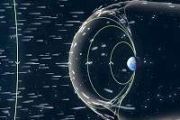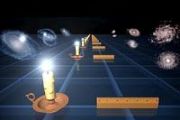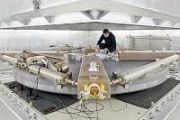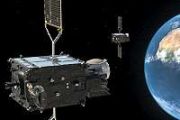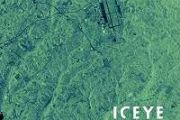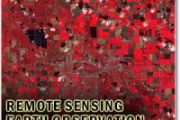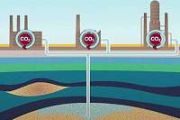
Copernical Team
Robot rock at LUNA
 Image:
Image:
ESA's robots get ready to rock at LUNA.
Also known as the Moon on Earth, the LUNA facility near the European Astronaut Centre (EAC) in Cologne, Germany, was unveiled in September 2024, a simulated lunar environment that prepares our return to the Moon. To celebrate, ESA astronaut Matthias Maurer joined forces with our robotics experts to showcase their cutting-edge machines Interact and Spot, and the potential of human-robot teamwork for space exploration.
Meet ESA’s robots: Interact, a wheeled robotic arm, and Spot, a robot dog. ESA’s robotics team in the Netherlands programs these machines for human-robot interaction experiments such as
Pale blue (supernova) dot
 Image:
Pale blue (supernova) dot
Image:
Pale blue (supernova) dot Chinese satellite network enhances maritime internet connectivity
 Spacesail Constellation, a Chinese commercial low-orbit satellite network, has successfully completed its inaugural network connection test, demonstrating the system's capability to support high-speed broadband services for maritime applications.
The test, conducted by Shanghai Spacesail Technologies Co., Ltd., assessed the ability of the satellite broadband network to deliver internet con
Spacesail Constellation, a Chinese commercial low-orbit satellite network, has successfully completed its inaugural network connection test, demonstrating the system's capability to support high-speed broadband services for maritime applications.
The test, conducted by Shanghai Spacesail Technologies Co., Ltd., assessed the ability of the satellite broadband network to deliver internet con Intuitive Machines enhances lunar and deep space data transmission services
 Intuitive Machines, Inc. (Nasdaq: LUNR, LUNRW), a leader in space exploration, infrastructure, and services, has expanded its collaboration with NASA by securing additional contracts from the Near Space Network (NSN) to provide Direct-to-Earth (DTE) services. These agreements underscore the company's integral role in advancing NASA's lunar and deep space missions.
DTE communication and nav
Intuitive Machines, Inc. (Nasdaq: LUNR, LUNRW), a leader in space exploration, infrastructure, and services, has expanded its collaboration with NASA by securing additional contracts from the Near Space Network (NSN) to provide Direct-to-Earth (DTE) services. These agreements underscore the company's integral role in advancing NASA's lunar and deep space missions.
DTE communication and nav India's space economy to grow nearly 5 times in next decade
 The Indian space economy is set to grow nearly 5 times from $8.4 billion to around $44 billion in the next decade, Union Minister of State for Science and Technology, Dr Jitendra Singh, has stressed.
Investments in the sector reached Rs 1,000 crore in 2023 alone, placing India as a frontline player globally. India's space sector has also emerged as a significant foreign exchange earner.
O
The Indian space economy is set to grow nearly 5 times from $8.4 billion to around $44 billion in the next decade, Union Minister of State for Science and Technology, Dr Jitendra Singh, has stressed.
Investments in the sector reached Rs 1,000 crore in 2023 alone, placing India as a frontline player globally. India's space sector has also emerged as a significant foreign exchange earner.
O Gilat secures $18M in orders for In-Flight Connectivity Solutions
 Gilat Satellite Networks Ltd. (NASDAQ, TASE: GILT), a global leader in satellite networking technology and services, has announced securing more than $18 million in orders for in-flight connectivity (IFC) solutions. These orders primarily involve Gilat's advanced SkyEdge platforms, associated services, and Solid State Power Amplifiers (SSPAs). The company plans to deliver the equipment and servi
Gilat Satellite Networks Ltd. (NASDAQ, TASE: GILT), a global leader in satellite networking technology and services, has announced securing more than $18 million in orders for in-flight connectivity (IFC) solutions. These orders primarily involve Gilat's advanced SkyEdge platforms, associated services, and Solid State Power Amplifiers (SSPAs). The company plans to deliver the equipment and servi MIT scientists pin down the origins of a fast radio burst
 Fast radio bursts are brief and brilliant explosions of radio waves emitted by extremely compact objects such as neutron stars and possibly black holes. These fleeting fireworks last for just a thousandth of a second and can carry an enormous amount of energy - enough to briefly outshine entire galaxies.
Since the first fast radio burst (FRB) was discovered in 2007, astronomers have detect
Fast radio bursts are brief and brilliant explosions of radio waves emitted by extremely compact objects such as neutron stars and possibly black holes. These fleeting fireworks last for just a thousandth of a second and can carry an enormous amount of energy - enough to briefly outshine entire galaxies.
Since the first fast radio burst (FRB) was discovered in 2007, astronomers have detect Parker Solar Probe reports healthy status after solar encounter
 Eight days after its record-breaking closest approach to the Sun's surface Dec. 24, 2024, NASA's Parker Solar Probe has confirmed the spacecraft's systems and science instruments are healthy and operating normally, including collecting science data as it swung around our star.
Breaking its previous record by flying just 3.8 million miles above the surface of the Sun, Parker Solar Probe hur
Eight days after its record-breaking closest approach to the Sun's surface Dec. 24, 2024, NASA's Parker Solar Probe has confirmed the spacecraft's systems and science instruments are healthy and operating normally, including collecting science data as it swung around our star.
Breaking its previous record by flying just 3.8 million miles above the surface of the Sun, Parker Solar Probe hur Researchers identify neutron stars as sources of fast radio bursts
 An international team of researchers, led by McGill University scientists, has confirmed a key link between fast radio bursts (FRBs) and neutron stars - extremely dense remnants of massive stars that explode as supernovae. This milestone discovery, derived from a detailed analysis of a single FRB, sheds light on the enigmatic radio flashes that have puzzled astronomers for over a decade.
"
An international team of researchers, led by McGill University scientists, has confirmed a key link between fast radio bursts (FRBs) and neutron stars - extremely dense remnants of massive stars that explode as supernovae. This milestone discovery, derived from a detailed analysis of a single FRB, sheds light on the enigmatic radio flashes that have puzzled astronomers for over a decade.
" January's Night Sky Notes: The Red Planet
 Have you looked up at the night sky this season and noticed a bright object sporting a reddish hue to the left of Orion? This is none other than the planet Mars! January will be an excellent opportunity to spot this planet and some of its details with a medium-sized telescope. Be sure to catch these three events this month.
h3>Martian Retrograde /h3>
Mars entered retrograde (or backward
Have you looked up at the night sky this season and noticed a bright object sporting a reddish hue to the left of Orion? This is none other than the planet Mars! January will be an excellent opportunity to spot this planet and some of its details with a medium-sized telescope. Be sure to catch these three events this month.
h3>Martian Retrograde /h3>
Mars entered retrograde (or backward 















